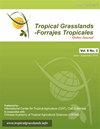青豆的生理、形态和生化特性Kuntze种子
IF 0.7
4区 农林科学
Q3 AGRICULTURE, DAIRY & ANIMAL SCIENCE
引用次数: 0
摘要
阿根廷山楂是一种灌木豆科植物,原产于南美洲热带地区,用于动物饲料和绿肥。在没有发芽指南的情况下,本研究的主要目的是确定进行发芽和加速老化测试的最合适温度。还对种子的生化特性进行了评估。在20、25、30和35°C的温度和20/30°C的交替温度(16小时:8小时)下,使用纸间法在发芽器中发芽,每天计数,直到发芽稳定(7天未发芽)。对于加速老化试验,水分含量在10-40%之间的种子使用了两个温度(41和45°C)和六个老化期(0、24、48、72、96和120小时)。测定了种子的碳水化合物(%)、乙醚提取物(%)和粗蛋白(%)以及宏量和微量营养素含量。结果表明,银合欢种子主要由淀粉(22.67%)和蛋白质(26.45%)储备组成,脂质含量较低。对于发芽测试,建议温度为30°C,以提高发芽率和速度,并在10天和20天进行幼苗评估。对于加速老化试验,建议在41°C下老化48小时,以从质量上区分银合欢种子批次。本文章由计算机程序翻译,如有差异,请以英文原文为准。
Physiological, morphological, and biochemical characterization of Cratylia argentea (Desv.) Kuntze seeds
Cratylia argentea is a shrub legume native to tropical regions of South America where it is used for animal feed and green manure. In the absence of germination guidelines, the key aim of this study was to define the most suitable temperature for conducting germination and accelerated aging tests. The biochemical attributes of seeds were also assessed. Seeds with 10% moisture from 4 different seed lots were germinated using the between paper method in a germinator at temperatures of 20, 25, 30 and 35 °C and alternating temperatures of 20/30 °C (16 h:8 h), with daily counting until germination was stable (seven days without germination). For the accelerated aging test, two temperatures (41 and 45 °C) and six aging periods (0, 24, 48, 72, 96 and 120 h) for seeds with between 10–40 % moisture content were used. Carbohydrates (%), ethereal extract (%), crude protein (%) and macro and micronutrient contents of the seeds were measured. Results showed that C. argentea seeds consist predominantly of starch (22.67 %) and protein (26.45 %) reserves with a low percentage of lipids. For the germination test, the temperature of 30 °C is recommended, allowing greater percentage and speed of germination, with seedling evaluation at 10 and 20 days. For the accelerated aging test, aging for 48 h at 41 °C is recommended to discriminate C. argentea seed lots in terms of quality.
求助全文
通过发布文献求助,成功后即可免费获取论文全文。
去求助
来源期刊

Tropical Grasslands-Forrajes Tropicales
Agricultural and Biological Sciences-Agronomy and Crop Science
CiteScore
1.60
自引率
0.00%
发文量
36
审稿时长
16 weeks
期刊介绍:
The Journal publishes, in English or Spanish, Research Papers and Short Communications on research and development, as well as contributions from practitioners (Farmer Contributions) and Review Articles, related to pastures and forages in the tropics and subtropics. There is no regional focus; the information published should be of interest to a wide readership, encomprising researchers, academics, students, technicians, development workers and farmers.
In general, the focus of the Journal is more on sown (''improved'') pastures and forages than on rangeland-specific aspects of natural grasslands, but exceptions are possible (e.g. when a submission is relevant for a particularly broad readership in the pasture and forage science community).
The Journal will also consider the occasional publication of associated, but closely related, research in the form of an additional scientific communication platform [e.g. a re-make of the former Genetic Resources Communication series of the former Division of Tropical Crops and Pastures of the Commonwealth Scientific and Industrial Research Organisation (CSIRO), Australia].
Areas of particular interest to the Journal are:
Forage Genetic Resources and Livestock Production[...]
Environmental Functions of Forages[...]
Socio-economic Aspects[...]
Topics within the aforementioned areas may include: Diversity evaluation; Agronomy; Establishment (including fertilization); Management and utilization; Animal production; Nutritive value; Biotic stresses (pests and diseases, weeds); Abiotic stresses (soil fertility, water, temperature); Genetics and breeding; Biogeography and germplasm collections; Seed production; Ecology; Physiology; Rhizobiology (including BNF, BNI, mycorrhizae); Forage conservation; Economics; Multilocational experimentation; Modelling.
 求助内容:
求助内容: 应助结果提醒方式:
应助结果提醒方式:


